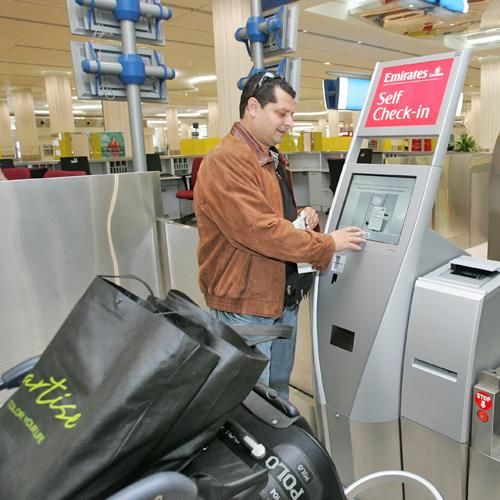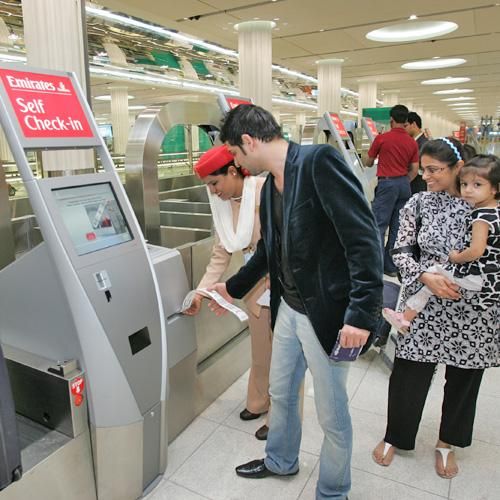Passengers using self-service kiosks at Dubai International Airport's Terminal 3 check-in their luggage, choose their seat and get their boarding passes – all in less than two minutes.
The 60 self-service kiosks are apart from the 180 regular manned check-in counters at the swanky terminal which opened on October 14.
“I'm surprised something like this is here and the long queues usually seen at the check-in counters are gone,'' said Asif Memon, 28, a real estate executive flying to Karachi on Tuesday. He was sent off by his sister Mahinoor and her two-year-old daughter Faleha to a self check-in kiosk.
The kiosks are smart enough to work on their own and flag down a luggage if it exceeds the IATA-mandated maximum weight of 32 kg, but few airport staff is on hand to guide first-time users.
More miles
“This gives me more time to shop at the Duty Free,'' said Sana Tayem, a Lebanese civil servant in Dubai, after using the self check-in kiosk for a flight to Beirut.
What surprises many people is that using the kiosks also earns them extra air miles, and first-time users vow they will avoid manual check-ins next time.
Mohammad Harb, who runs a lingerie manufacturing business, was surprised to know about the extra 500 Skywards air miles he got for using it.
Despite these enticements, less than five per cent of outbound passengers use them.
Mohammed Mattar, senior vice president of Airport Services of Emirates, said he expects more people to use self-service kiosks.
“This is a huge facility, but we're off to a smooth start. We're working to ensure passenger experience improves with time. We make no excuses for mistakes. Now there's a solution to avoid long queues at check-in counters,'' he said.
Only one luggage per passenger is allowed for kiosk users at the moment.
“Many European and North American airports offer self-service kiosks too but not in the scale Terminal 3 has done,'' said Mattar.
He said they are working with aviation authorities in other countries, such as the US and India, requiring advance passenger information (API), to allow the use of self check-in facilities to scan passengers' passports and other procedures currently done manually by staff at regular counters.
Emirates Airlines moved all its flights to Terminal 3 on November 11 - less than one month after the $4.5-billion airport first opened - starting with Gulf and North American flights.
In the first five weeks operation, more than half million people flew out of terminal three but only 20,500 have used the self-service kiosks (including the 6,800 who checked in baggage).
How self check-in works
- Passenger must go to one of the 60 self check-in counters: 36 counters in economy class and 24 counters in first and business class. Only one case is allowed (weight depends on destination airport); no oversized baggage.
- Self check-in can be done in three different ways: a) Skywards card [Emirates loyalty programme], b) e-ticket and c) bar code [paper ticket].
- Passenger's booking details appear after kiosk scans ticket bar code or Skywards card. He selects a seat. Passenger must say yes/no to security-related questions (similar to an online affidavit: Is this baggage yours? Did you pack it yourself? Are you sure the contents don't violate any laws?).
- Kiosk asks passenger to place luggage on conveyor belt (maximum allowable weight is 32kg, passengers bound for UK are only allowed a maximum of 23kg in each bag, while it is 40kg for Nigeria-bound passengers).
- Passenger takes boarding pass and luggage tag from one kiosk (passenger must attach tag on luggage himself). Get claim stub from the tag to use in claiming luggage at destination airport.
- Passenger goes to any of the 52 immigration counters and 12 e-Gate counters.
If changes in ticket details are not updated and if passenger is using the old paper tickets (no bar code) self-service kiosks can't be used.














